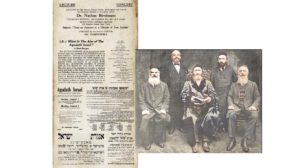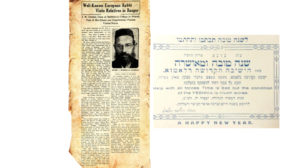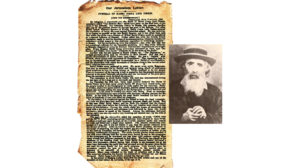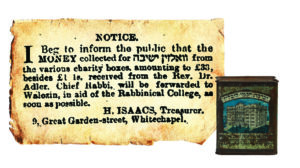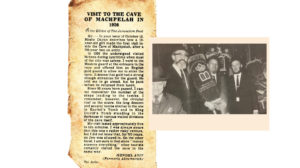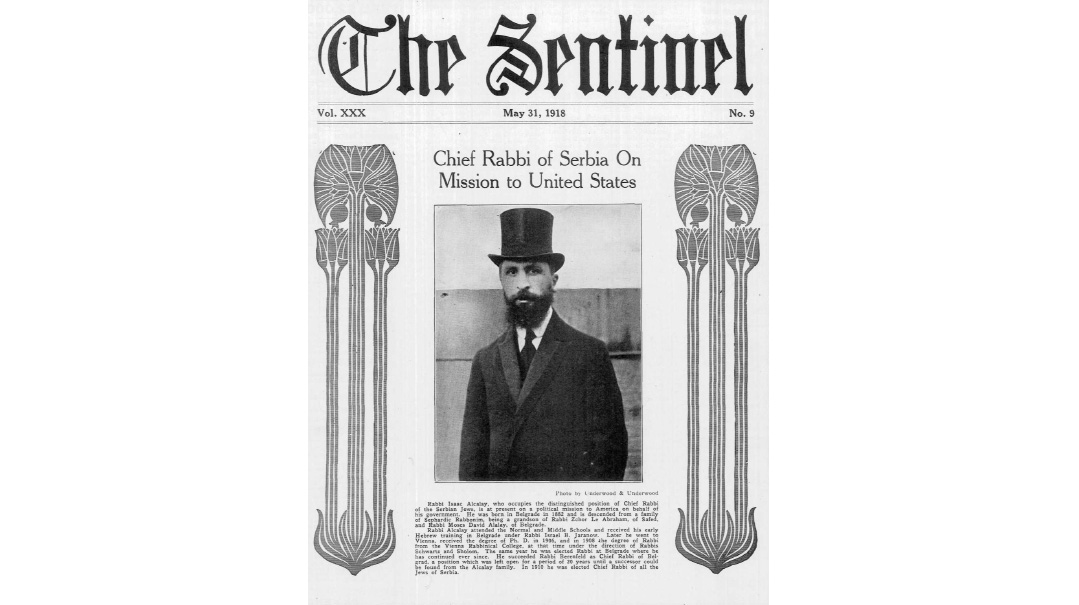The Yekke List
| March 23, 2021Eight figures who made sizable postwar contributions to Jewish life in a variety of fields

Title: The Yekke List
Location: Mir, Poland
Document: List of German students studying at Yeshivas Mir
Time:1936
Thank you to Rav Yaakov Bender, Rav Shlomo Zev Carlebach, Rav Yisroel Meir and Rav Mordechai Stern, Eli Neuberger, and Akiva Yasnyi for their assistance with this column.
The great Torah centers of Eastern Europe saw only a handful of students venturing in from Germany in the decades after Rav Shamshon Raphael Hirsch founded his separatist Frankfurt community in 1876. That trickle of Yekkehs increased to a stream with the Nazis’ rise to power in 1933. The largest contingent — peaking at nearly 50 young men — joined the Mir yeshivah in Poland.
For veteran Mirrers, this was an interesting turn of events. Traditionally German Jews referred to their brethren in the Russian Pale as Ostjuden (Eastern European Jews), with more than a hint of condescension. But these fresh imports were eager to show what they could offer. Well advanced in secular education (some even had PhDs), they quickly adapted to the abstruse form of critical thinking needed to grasp difficult sugyas. They even accustomed themselves to life in the primitive Polish backlands — a far cry from the modern conveniences they’d been accustomed to in Germany.
The deutsche drank in the mussar shmuessen of Rav Yerucham Levovitz, who also established a Chumash shiur exclusively for the German and American students. The content of these classes was subsequently published in the six-volume set Daas Torah.
The German students benefited the Mir in an additional way. Many of them came from middle-class backgrounds, but were not advanced in their Torah learning. The Polish talmidim, on the other hand, often came from poverty-stricken homes, but were more than able to assist a study partner in moving forward. A perfect shidduch was made: the German talmidim hired seasoned Mirrer talmidim as tutors, providing them with funds beyond the yeshivah’s usual chalukah.
Hitler’s Nuremberg laws, however, worsened the economic situation of German Jewry starting in September 1935. The financial faucet was turned off as German Jews lost their jobs and restrictions were placed on international bank transfers.
Fortunately, that same year, the US-based Joint Distribution Committee provided salvation. Designating the German students as refugees from the Nazi regime, the Joint allocated handsome monthly disbursements to yeshivos for these talmidim. As more students arrived from Germany, Rav Avraham Kalmanowitz compiled a list of names and traveled to America to beseech the Joint leadership for additional funding. With the help of Rabbi Leo Jung, Harry Fischel, and others, he succeeded — and the yeshivah was able to maintain its German contingent through the prewar years.
Among the nearly 50 entries on this list submitted to the Joint, many, such as Rav Shlomo Wolbe and Rav Naftali Neuberger, are household names. We chose to profile eight other figures who made sizable postwar contributions to Jewish life in a variety of fields.
Rabbi Naftoli Carlebach (1916–2005)
Scion of an esteemed rabbinic family, Naftoli Carlebach went as a 16-year-old to learn in Telshe before coming to the Mir in 1935. Narrowly escaping Europe with the help of his friend Rav Naftali Neuberger, he came to Baltimore, where another German Mir talmid, Rav Shimon Schwab, made the shidduch to his trusted assistant in Vaad Hatzalah work — Miss Gittel Gutman. Rabbi Carlebach served briefly as rabbi of Chambersburg, Pennsylvania, and then moved to Detroit, where he served as a rav and taught in Beth Yehuda. He was also instrumental in helping Rav Leizer Yudel Finkel raise funds for the Mir in Yerushalayim.
He eventually would move to New York, where he helped found the Mir Minyan in Boro Park, before retiring to Eretz Yisrael in 1979. He was involved in the translation of the works of Rav Shamson Raphael Hirsch, and his concise notes were used in the publication of seforim of his rebbi, Rav Eliyahu Meir Bloch. Among his esteemed children is Rav Binyomin Carlebach, a son-in-law of Rav Beinush Finkel and a rosh yeshivah in Mir Yerushalayim.
The Return
Rav Shimon Schwab related that the Chofetz Chaim told him it was obvious why students from Germany had begun learning in the world’s premier yeshivos. He said that throughout Ashkenazi Jewish history, much Torah originated in Germany — many Baalei Tosafos, the Rosh, the Maharil, and other Rishonim. Although traditional Jewish life in Germany had deteriorated greatly over the previous centuries, these yeshivah bochurim were the expression of the Torah’s repayment for the early glory. The Chofetz Chaim’s way of articulating the special historical role these individuals were playing instilled confidence in them to achieve great things in the future.
Rav Uri Shraga Hellman (1917–2008)
After arriving in Mir from Germany, Reb Uri stayed with the yeshivah through the war years, in Vilna and in Shanghai. During the war he married Chaya Bluma Sher, whose father Rav Nachum Sher was a talmid of the Volozhin yeshivah. In the United States he became a Bais Yaakov pioneer with the legendary Rebbetzin Vichna Kaplan in Williamsburg and later in Bais Yaakov of Boro Park, where he was the menahel for over 60 years.
Extremely modest, he hid his great Torah knowledge from others, but his intense avodas hamussar was apparent to all. He would express his gratitude to Hashem throughout his life for the miracles that had enabled his survival during the war. At a Bais Yaakov dinner in his honor, this eternal hakaras hatov was the central theme of his speech. As a longtime member of the Mir Minyan in Boro Park, he kept his connection to his alma mater close — a connection that was strengthened through his son Rav Yitzchak Hellman shlita, who married the daughter of the Mir rosh yeshivah Rav Nochum Partzovitz and is today a maggid shiur in Mir Yerushalayim.
Rabbi Yosef Fabian (1914–2014)
After studying at the yeshivah in Montreux, Switzerland, the Breslau-born Yosef Fabian joined the German contingent in the Mir, where he would spend the next decade. He fled with the group to Shanghai and got married there. Rabbi Fabian founded a branch of Agudath Israel in Shanghai, and after the war, he settled in Washington Heights, where he served as the leader of the local chapter of Zeirei Agudath Israel.
In 1948 he moved to Cleveland, where he would spend close to seven decades as an educator and community leader. While his official title was associate director of Yeshivath Adath B’nai Israel, he served many different roles, working with local immigrant youth and teaching them for their bar mitzvahs.
At a tribute dinner held in 1993 in his honor, a grateful student paid tribute to Rabbi Fabian for 40 years of service to YABI: “Rabbi Fabian has done virtually everything… from driving children through snowstorms to knocking on doors for recruitment, raising funds, and even doing repair work on the building. Every Shabbat, rain or shine, he has made the four-mile round-trip walk from his home on Compton Road in Cleveland Heights to the YABI building on Warrensville Center Road….”
Rabbi Moses J. Cohn (1913–1994)
Rabbi Cohn was born in Hamburg, Germany, where he attended the Talmud Torah Realschule and eventually became a part-time student at the University of Hamburg before joining the Mir. When the yeshivah fled to Vilna in 1939, the rosh yeshivah Rav Leizer Yudel Finkel tasked Moses with acquiring dollars on the black market exchange to buy passage out of the Soviet Union on the Trans-Siberian railroad. Possession of dollars was a capital offense, and Moses risked his life in these operations. Once, when he was arrested, he managed to escape through an unlocked window.
Prior to his departure, the rosh yeshivah urged Moses to enter a fictitious marriage with a Bais Yaakov teacher named Devorah Applegrad so that both could travel on the same visa, which saved her life when they escaped to Kobe, Japan. After they arrived in America, they went on to marry for real, settling in Boston, where Rabbi Cohn was the principal of the Maimonides School for more than 30 years. Working alongside Rav Soloveitchik and his wife Tonya, Rabbi Cohn helped build a high-level curriculum and develop Maimonides into one of the country’s leading day schools. Rabbi Cohen and his family stood at the forefront of many noteworthy Jewish causes in Boston.
Rav Ezriel Langa (1915–1996)
Frankfurt-born-and-bred Ezriel Langa was strongly influenced by Rav Breuer and Rav Schlesinger, and he credited the latter with ensuring he chose a path of Torah. He was known as a masmid among the Mir’s many masmidim. Following his sojourn in the Far East, he came to New York. He taught at JEC in Elizabeth before joining several fellow eltere Mirrers at Torah Vodaath, where he was a beloved rebbi. Rabbi Langa was chosen by Rav Aharon Kotler to be the baal Mussaf at Beth Medrash Govoha for the Yamim Noraim. This was a familiar position for Rav Langa, who recalled leading Selichos in Vilna during the early war years in a minyan with Rav Elchonon Wasserman.
Although Rav Langa and his wife unfortunately never had any children, he was fondly remembered by acquaintances for his perpetual simchas hachayim. He left behind a number of manuscripts. One of them, a classic commentary on Chumash, was published as Sefer Ikvei Erev, its title an ode to the daily early morning learning sessions where the chiddushim were penned.
Rav Shamshon Rephael Weiss (1911–1990)
Along with Rav Shimon Schwab, he was among the first Germans to come to the Mir in 1929. Rav Leizer Yudel once commented, “The entire burden and responsibility of the Mir yeshivah is worthwhile for a talmid like Shamshon Rephael.” In 1934 he took a position as seminar rabbiner in the Würzburg Seminary, where he influenced many of his talmidim, including Binyomin Zeilberger and Naftali Neuberger, to join the Mir. He himself would return for a few months in 1936 to “chap a shtickel Mir.”
In 1936 Rav Weiss married Leah Carlebach, the sister of the aforementioned Rabbi Naftoli Carlebach. In 1939 they immigrated to the United States, where he held some of the most important leadership positions in American Orthodoxy: one of the founding presidents of Torah Umesorah, executive director of Young Israel, and executive vice president of the Orthodox Union (OU).
Despite his many titles, Rav Weiss considered himself first and foremost a talmid of Mir yeshivah, and instructed that “Talmid Yeshivas Mir” should be the sole accolade inscribed on his matzeivah. He worked tirelessly for the yeshivah, serving as president of the American Mirrer Association. In 1972 Rav Weiss retired to Eretz Yisrael to where he taught at various yeshivos and seminaries, and once again had an opportunity to become a talmid in Yeshivas Mir Yerushalayim.
Reb Moshe Zupnik (1918–2010)
Several years after Moshe Zupnik arrived in Mir from Frankfurt, he was thrust into the limelight, and was the man of the hour when it came time to rescue the yeshivah. Indeed, it can be safely asserted that Reb Moshe Zupnik was personally responsible for the miraculous rescue of the Mir yeshivah and their escape to Shanghai.
Zupnik was initially tapped to be the yeshivah’s emissary to Japanese consul Chiune Sugihara, negotiating for visas on behalf of the entire group. Soon thereafter, as Sugihara became overwhelmed by the volume of visa requests, Moshe volunteered to assist him in his office with processing the applications. Using his German language skills, he even formed a rapport with Sugihara’s German assistant Wolfgang Gutsche — a Nazi and Gestapo agent. During those tense weeks in Kaunas (Kovna), Lithuania, during the summer of 1940, an extraordinary scene played out: the Japanese consul was distributing visas to Jewish refugees, and was assisted in this endeavor by a German Nazi and a yeshivah bochur.
Following the war, Moshe Zupnik settled in Boro Park, where he worked in the textile industry and studied with his longtime chavrusa Rav Uri Hellman for decades.
Rav Binyomin Zeilberger (1921–2005)
Arriving in the Mir as a green 14-year-old from Würzburg, Reb Binyomin Zeilberger attributed his phenomenal growth in learning to his relationship with distinguished senior Mirrer talmidim worthy of being roshei yeshivah in their own right, including Reb Leib Malin, Reb Yonah Minsker, and Reb Michel Feinstein, with whom he shared a stantzia.
While he only managed to catch a short glimpse of the great Mir mashgiach Rav Yerucham Levovitz, he would eventually marry his granddaughter, the daughter of Rav Yisrael Chaim Kaplan. Following the war, Rav Binyamin joined Rav Leib Malin, Rav Chaim Vysokier, and other senior eltere Mirrers in founding Yeshivas Bais Hatalmud, where he was famed across the Torah world for his encyclopedic knowledge of Shas. With the passing of those giants, he would become the rosh yeshivah there in his later years.
(Originally featured in Mishpacha, Issue 854)
Oops! We could not locate your form.

